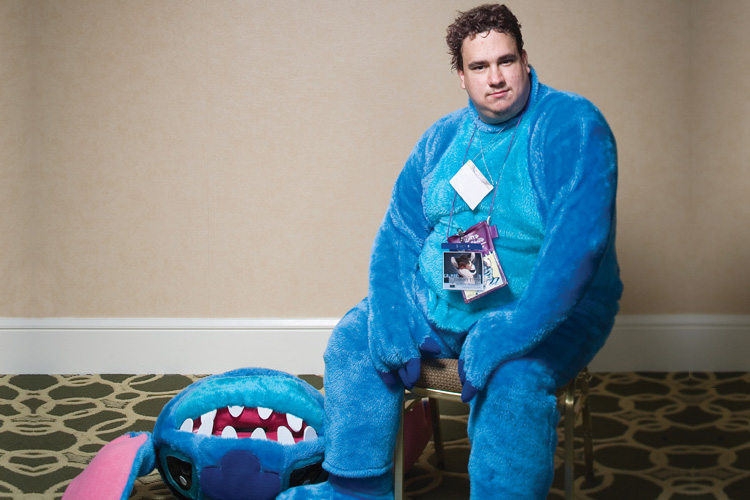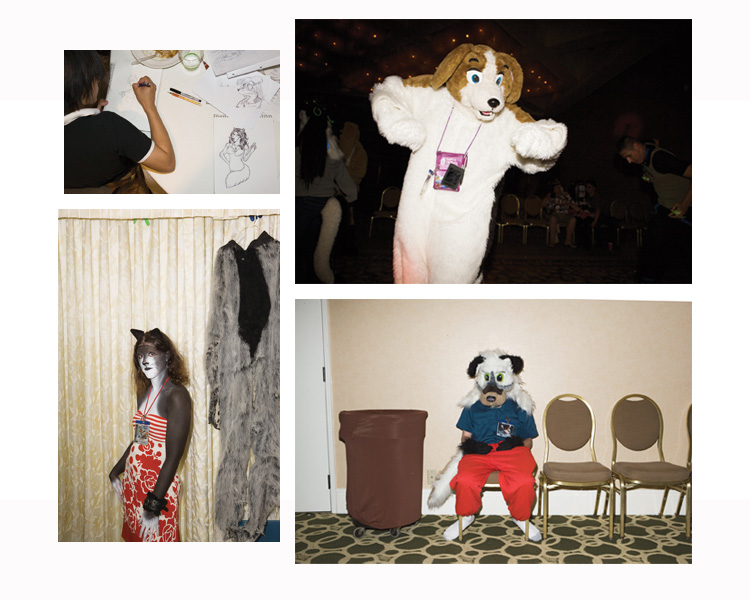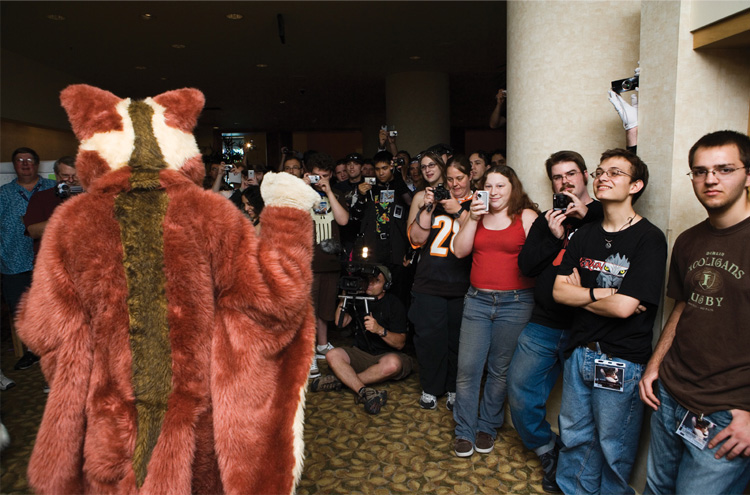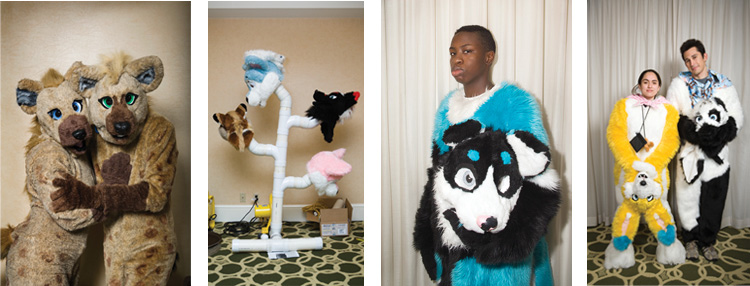Furries
By Camille LowryPhotos by Peter Bohler

In recent years, the subculture known as the Furry Fandom has been the subject of episodes of Entourage and CSI, and profiled in Vanity Fair. In each portrayal, furries were shown as sex-crazed oddballs in animal-mascot outfits. However, the members of this community insist they have been misrepresented. There is far more to their world than “Johnny Drama” spanking Shanna Moakler in a bunny suit.
The furry fandom consists of people who appreciate humanoid animal characters in art and media. Many older furries, or “graymuzzles,” credit classic animation like Kimba, The White Lion and Watership Down for inspiring animal fascination. Furry characters also include fantastical creatures such as unicorns, werewolves and satyrs.
The website for the furry convention Anthrocon defines the community with the following statement: “We are bound together across the most daunting barriers by our mutual admiration for these beasts of myth and legend who, by simple reflection, give us a better window into ourselves.”
Just like the diversity found in most large groups, there are vast differences between furries. Many are artists or art enthusiasts. A subgroup claims to have spiritual connections with animals and practice a sort of Native American totemism. Some assume an animal alter-ego, known as a fursona, totem or avatar. And of course, some are interested in costuming and role play. They allow themselves to continue the childhood make-believe that other adults have curtailed.
Furry fandom developed in the early 1980s at science fiction and comic book conventions. The furry crowd followed a subsection of fantasy and science fiction stories that featured animal protagonists, such as Omaha the Cat Dancer and Teenage Mutant Ninja Turtles. They hosted anthropomorphic animal-themed parties in their hotel rooms, called “furry parties.” Pre-internet, the fandom grew through word-of-mouth invitations, fliers and occasional ads in comics. Over time, the popularity of these parties grew, establishing a critical mass large enough for its own convention.
ConFurence, the first specifically furry convention, was organized in 1989 by Mark Merlino, V.P. of engineering for a communications company, his partner, songwriter Rod O’ Riley, and friends. Sixty-five people convened at the Costa Mesa, Calif., event.

Attendance grew steadily over the years, eventually exploding with the internet, which continues to be the main furry tether. Now there are more than 40 furry conventions worldwide. Anthrocon, the largest with nearly 3,000 participants, takes place in Pittsburgh. Further Confusion in San Jose, The Midwest Fur Fest in Illinois, and Furry Weekend Atlanta also have big turnouts.
Norman Rafferty, of the Anthrocon convention staff, is not sure why furries have gotten such attention. He says, “They play it up in the media. But really, furries are a bunch of nerds. They look like normal people. They show up in T-shirts and jeans.”
Sarah Silverman of Seattle, age 25, discovered the fandom in high school. She was fond of drawing the cat warriors in the card game Magic: The Gathering. “I started looking up these warriors [on the internet],” she says, “and found this whole culture of people that draw this stuff.” She began following certain artists on the web and became a regular at Orange County’s Califur.
This year’s Califur program included the requisite fursuit parade, dances and panels with featured artists. Workshops were presented on topics such as “Anatomy for the Furry Artist.” There were “Furums” where people could socialize with their co-felines or attend a “sea-critter meet.” The screening room showed films like The Golden Compass and Charlotte’s Web.

Sarah says many furries “got teased badly as kids or as adults, and here they are not. I was a girl who was into dinosaurs and science instead of the stereotypical girl stuff. These other people are into what I’m into. Humans are always looking for social acceptance from our parents, lovers or wherever. This is one outlet where you can find it.”
Furries can be found anywhere. “We went to an Oklahoma convention in a state park,” Mark says, “and there was a guy chewing on a straw, leaning up against a pickup, with a malamute licking his face. He goes, ‘My name’s Clemp, this here’s my truck, this here’s my dog. I’m a furry.’ And I go, ‘OK!’ There are furry rednecks. The furry bug bites every type.”
There are two distinct groups propelling therianthropic interests—those who live a furry lifestyle and fans who are just art creators and patrons. “A lot of people in the fandom haven’t even been to a convention, but trade art online,” Mark says. “The art is the ambassador of the fandom and the community.” Websites such as WikiFur and Fur Affinity allow people to view thousands of pictures, and share their own.
A large part of what attendees do at these conventions is collect art and memorabilia, most often commissioning artists to draw their fursona. Guest artists have included Peter Laird, co-creator of the Teenage Mutant Ninja Turtles, Marc Evanier of the Garfield comic strip, and Scott Shaw, co-creator of Comic-Con.
People create fursonas for escapist fantasies or as vehicles for self-discovery. Norman’s fursona is a rat. “I have the lab-rat mentality of doing things over and over again,” he says. “So I have that [fursona] as a humorous reminder to myself to break out of these habits.”
Of Mark and Rod’s avatars, Rod says, “Both of us are extreme otter fans, but we consider ourselves to be not worthy. So Mark is a Pine Marten, and I’m a mink. He’s a weasel in the trees, and I’m kind of an otter with attitude.”
Sarah’s character is a black-and-white tuxedo cat. “I’ve had pet cats since I was four,” she says. “I did ballet when I was little, and I just associated grace, poise and natural exuberance with cats. It was a natural progression for me.” In character she finds herself to be a little more outgoing.
Some people take the fantasy to the outer limits and create hybrid avatars. “This is normal in the fandom,” Mark says. “Most people will go, Oh, you’re a cheetah-giraffe? OK, that’s fine.”
“Foxes are the most popular fursona, because you’ve got a lot of gender-confused people,” Mark continues. “They look around and go, What’s a really cute androgynous animal? A fox. They’re kind of cat-like, but they’re dogs. And they have delicate features.” Some men claim female characters, and straight women might draw gay male ones. Hermaphrodite fursonas exist as well.
Sexuality and eroticism are dimensions of the fandom, but not necessarily the primary ones. There is great frustration among furries at the insistence of the media to present them as deviants. Sarah was recently upset by a radio program that equated a furry to a pedophile dressing up as a clown and going to a kid’s birthday party. She says, yes, they dress up sometimes, but they are not trying to hurt anyone.
Outsiders have also raised eyebrows at the practice of “skritching,” which is a mock grooming, or the scratching of someone’s shoulders or scalp as a friendly greeting. “Furries don’t have a sense of personal space,” Rod says. “It’s not really a sexual thing.”
One of the largest misconceptions is that everyone in the fandom wears a fursuit. A survey of 600 furries was taken by the Department of Psychology at the University of California at Davis in 2007. The results showed that only 18% have fursuits.
“You’ve got to understand that fursuits put tremendous strain on your body,” Mark says. “They are incredibly hot. You do not dress up in those suits and have sex. That’s just ridiculous.” He also discounts the concept of fursuit orgies, or “furpiles,” as impossible. “The thing is, the fursuit is not the kink,” Mark says. “The idea that animal people are attractive and wouldn’t have the same inhibitions as humans, that’s the kink.”
Fursuits are often handmade. They can look sweet like a mascot or ultra realistic. Construction can take between 10 days and six months. Some people create suits so impressive that they’ve been hired to make costumes for the entertainment industry. Lionel Hassell , a former engineer in Atlanta, is one such artist in demand. He is booked until February of next year with orders that can run as high as $4,000. Lionel adds equipment to his costumes to give his clients infrared, ultraviolet or heat vision. He explains it as, “expanding your senses, expanding your world.”
Lynne has been in the fursuit business since 1997. Previously, Lynne created costumes for her college theater department and studied taxidermy. Lynne enjoys making dragons the best, but her most common commissions are wolf suits. Lynne also makes naughty costumes. “I get a lot of request for penis and ball coverings,” she says. “The furry shaft and scrotum thing they can use with their own penis. And fake boobs are big. And fake furry vaginas. Those are velcro removable.”

Lynne says there are PG Furs and Naughty Furs. “There’s a group of people who are very strict about no sex-play, no reference to anything adult in fursuits ever. Then there’s this other group of people sneaking around having liaisons.” She considers herself PG. She says, “I just love it for losing yourself in this whole other character.”
Much of the art has adult content, known as “yiffy.” “Yiff” is the term furries use to refer to anything sexual. It’s derived from the sound foxes make while mating. Mark believes that furs have a scandalous reputation because the art portrays popular childhood images in risqué scenarios; characters that are not designed for adults, drawn in a way for adults to enjoy.
Also contributing to the negative image are small subsects with controversial fetishes, such as “baby furs,” who dress like infants, diapers and all, “plushophiles” who have sex with stuffed animals, and those who practice bestiality. Of the latter, Sarah says, “That’s not furry, that’s inhumane. I don’t care if your totem animal is a German shepard, and you think you are a German shepard. You’re not. You should leave the dog alone.”
Most furries claim that any bad is greatly outweighed by the good. “People have gotten jobs in art or with game companies, found life partners,” Mark points out. “I’ve been with Rod for 26 years, which is longer than most marriages last.”
The main draw of the furry fandom is the camaraderie that can be found there. “When you are around fans of whatever you are a fan of, you’re comfortable because you are around people who get it,” Rod says. “And you can move beyond it. So it’s like, I’m a furry, you’re a furry, well great—how about them Mets?”


